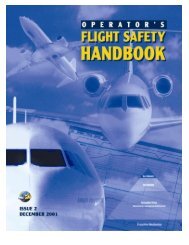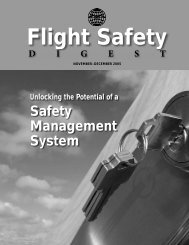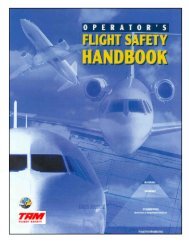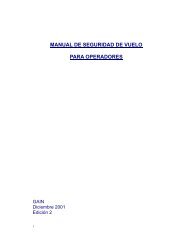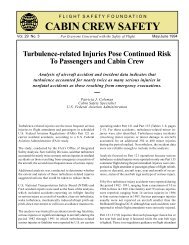Download PDF [10.9 MB] - Flight Safety Foundation
Download PDF [10.9 MB] - Flight Safety Foundation
Download PDF [10.9 MB] - Flight Safety Foundation
Create successful ePaper yourself
Turn your PDF publications into a flip-book with our unique Google optimized e-Paper software.
THREATANALYSIS<br />
wind reports were issued to the crew before touchdown, the<br />
final one for wind from 290 degrees at 27 kt gusting to 49 kt.<br />
“The investigation showed that wing tip contact with the<br />
runway was not due to a single human error, a malfunction<br />
of the aircraft or inadequate organisation; rather, it was due<br />
to a combination of several factors,” the report said, citing<br />
the automatic transition from lateral flight mode to lateral<br />
ground mode control laws when the left gear first touched<br />
down, resulting in half of full travel in response to full sidestick<br />
deflection.<br />
“The fact that there were no significant gusts during the<br />
decrab procedure explains that the aircraft was not brought to<br />
this unusual and critical attitude by direct external influence. …<br />
The BFU is of the opinion that the captain as pilot-in- command<br />
did not reach his decision using … reasoning [regarding lower<br />
crosswind component on Runway 33], because he did not regard<br />
the value maximum crosswind demonstrated for landing<br />
preparing for an approach, while all respondents<br />
cited control tower wind reports as their primary<br />
source. “So the reported wind that they got<br />
just before landing was not taken into account<br />
[in the occurrence reports],” van Es said. “And<br />
what happened in the 30 minutes that [elapsed<br />
as they] were planning the approach [was that<br />
by] the actual landing, the wind had changed.<br />
That happens all the time; the wind encountered<br />
is completely different from what is reported.<br />
They got a much stronger wind.”<br />
Frequently in cases selected, the pilot flying<br />
used an incorrect crosswind technique, not<br />
following the manufacturer’s recommendation.<br />
Even low-velocity crosswind/gusts can be very<br />
difficult if the flight crew fails to correctly apply<br />
the procedure.<br />
Figure 1 from the NLR work gives a sense<br />
of the pilots’ expectations versus the reality<br />
they encountered in comparable models/types<br />
of large commercial jets. “For several cases —<br />
excursions, hard landing, tail strikes, wing/pod<br />
strikes — what we see is that more than half<br />
of these occurrences [take place in crosswind<br />
conditions that are less than] what was demonstrated,”<br />
he said.<br />
The two most prevalent wind sensors approved<br />
for airport runways with accurate gustmeasurement<br />
capability are the cup/propeller<br />
as an operational limit for the aircraft. Civil air transport pilots<br />
were generally poorly informed about the effects of crosswinds<br />
in weather conditions such as these.”<br />
During this investigation, 81 pilots holding air transport<br />
pilot licenses and employed by five different airlines provided<br />
anonymous survey responses in which they were about<br />
evenly divided in understanding maximum demonstrated<br />
crosswind as a guide versus a limit. Significant differences in<br />
understanding also were found concerning the practical application<br />
of maximum demonstrated crosswind.<br />
The serious incident involving the Airbus A320-211 at Hamburg<br />
on March 1, 2008, and related events were analyzed and safety<br />
recommendations about landing in strong gusty crosswind conditions<br />
were issued by the German Federal Bureau of Aircraft Accident<br />
Investigation in Investigation Report 5X003-0/08, March 2010.<br />
— Mark Lacagnina and Wayne Rosenkrans<br />
type with a wind vane, and the ultrasonic type<br />
(often called sonic type). Both measure data<br />
within 2 to 4 percent of the correct value.<br />
“The normal [ATIS/control tower] wind<br />
report that you get is an average,” van Es said. “It<br />
is a forecast of the wind that you’re supposed to<br />
expect. Many pilots think it is an actual [realtime]<br />
measurement; it is not. It is a two-minute<br />
average, and they came up with this [to provide<br />
users] a good balance between the mean error<br />
and the absolute error in the forecast.”<br />
The NLR report published by EASA includes<br />
a list of recommended mitigations for the issues<br />
identified, and van Es discussed some examples.<br />
“First of all … include gusts when decomposing<br />
reported wind into the crosswind component<br />
and take the gust component [as] fully perpendicular<br />
to the runway,” he said. In the United<br />
States in the 1950s and 1960s, this practice was<br />
mandatory, NLR found. <strong>Flight</strong> crews always<br />
should use the most recent wind report in decision<br />
making.<br />
Despite the willingness of controllers to<br />
provide a series of instantaneous wind reports<br />
on request during an approach involving strong<br />
gusty crosswinds, NLR researchers advise<br />
against using this source. “[In] several incidents<br />
… the pilot was asking for … the instantaneous<br />
wind every 10 seconds,” he said. “And [these<br />
42 | FLIGHT SAFETY FOUNDATION | | AEROSAFETYWORLD | MAY 2013


![Download PDF [10.9 MB] - Flight Safety Foundation](https://img.yumpu.com/18550968/44/500x640/download-pdf-109-mb-flight-safety-foundation.jpg)

![Download this Issue [PDF 7 MB] - Flight Safety Foundation](https://img.yumpu.com/18859635/1/190x245/download-this-issue-pdf-7-mb-flight-safety-foundation.jpg?quality=85)
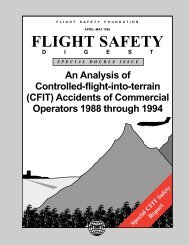
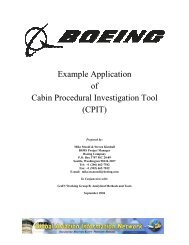
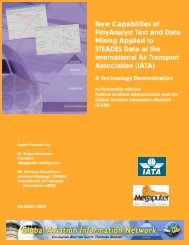
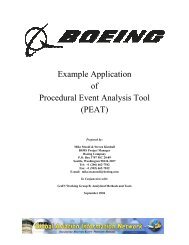
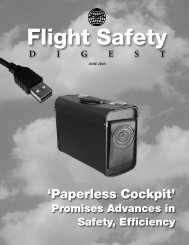
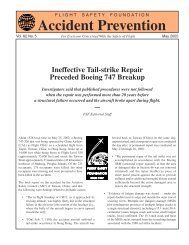
![Download [PDF 8 MB] - Flight Safety Foundation](https://img.yumpu.com/18859366/1/190x245/download-pdf-8-mb-flight-safety-foundation.jpg?quality=85)
